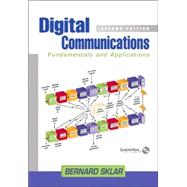
DR. BERNARD SKLAR has over 40 years of experience in technical design and management positions at Republic Aviation, Hughes Aircraft, Litton Industries, and at The Aerospace Corporation, where he helped develop the MILSTAR satellite system. He is now head of advanced systems at Communications Engineering Services, a consulting company he founded in 1984. He has taught engineering courses at several universities, including UCLA and USC, and has trained professional engineers worldwide.
(NOTE: Each chapter concludes with a Conclusion, References, Problems, Questions, and CD Exercises.)
1. Signals and Spectra.
Appendix 8A. The Sum of Log-Likelihood Ratios.
9. Modulation and Coding Trade-Offs.The New copy of this book will include any supplemental materials advertised. Please check the title of the book to determine if it should include any access cards, study guides, lab manuals, CDs, etc.
The Used, Rental and eBook copies of this book are not guaranteed to include any supplemental materials. Typically, only the book itself is included. This is true even if the title states it includes any access cards, study guides, lab manuals, CDs, etc.